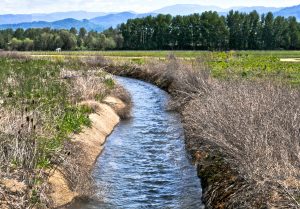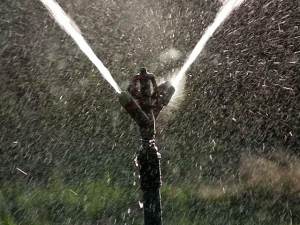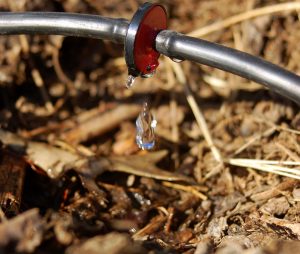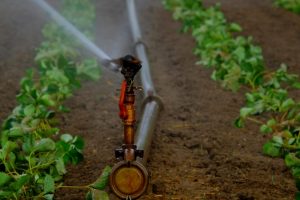
Water is the most significant factor in plant production. Specific plant types need various amounts of water during their growth cycle, at different times. The plants obtain water by heavy rain or floodwaters of the rivers that inundate vast areas of land during floods. As these are natural processes, heavy rain can occur, destroying the crops, or causing a lack of supplying the crops with water. So an artificial system is needed to collect and store water so that it can be used when appropriate. The scientific method is called “irrigation”.There are also various forms of irrigation. Description of the irrigation method, history of irrigation, methods to irrigation scheduling, descriptions of irrigation is described below.
Table of Contents
What is Irrigation?
Irrigation can be described as the science of the artificial application of water to the soil to satisfy the crop’s water requirements during the crop cycle for the full nourishment of the crops. Irrigation water will be given as soon as the humidity drop to the optimal point. The volume of water providing full crop yield is considered an optimal degree of water. The corresponding yield reduction is more or less than the optimal amount.
Irrigation history

Irrigation is the oldest method of supplying human food. The irrigation network used by ancient people from various areas to provide water to their fields. Irrigation at the period was primarily the regulation of the movement of water. Mesopotamia and Egypt were the most successful user of the irrigation system. A brief overview of the irrigation history is provided below.
Egypt
Ancient Egypt’s irrigation network was focused primarily on the Nile River. Water had been distributed from the Nile to the fertile fields. The biggest challenge for Egyptian irrigation was the unpredictable amount of water flowing into the Nile. Flood and water shortages are very normal at both high and low water flow rates. Tiny basins, canals were designed for irrigation purposes to collect water.
Mesopotamia
Mesopotamia (today Iraq and several areas of Iran) was synonymous with the territory of two Tigris (to the north) and Euphrates (to the south) rivers. As the rains were intermittent, irrigation was highly important in Mesopotamia for its agriculture. Another issue was that a large volume of silt was carried by Tigris and Euphrates which triggered floods.
Approaches for Irrigation
The value of irrigation to humanity is quite strong. Scheduling of irrigation dictates where exactly how much water needs to be added to the ground. Scientists and growers use various methods to schedule irrigation.
Soil moisture depletion approaches
A strong measure of the usable soil moisture in the root can be used for scheduling irrigation. The volume of water that lies between the capability of the field and the permanent wilting point is considered the moisture content accessible.
The plant does not readily have the moisture content below the wilting stage for subsequent application. Typically 75-80 percent of the moisture required is more quickly absorbed by plants named readily accessible moisture. To keep crops growing properly, irrigation will begin when 50% of the usable water is drained in the soil root zone and continues until the optimal amount is achieved. Soil moisture may be calculated using various techniques, such as the gravimetric test, blocks of electro-resistance, tensiometer, etc.
Plant basis
Plants may serve as a reference for irrigation scheduling. Plants may indicate water deficiency by different signs such as curling or rolling of leaves and changing the color of the leaves. Each of these symptoms is indicative of water being provided by the plant. Plant-based irrigation scheduling has only disadvantages as it does not provide the objective estimation of the deficit of moisture.
Critical growth approach
Critical growth approaches each crop has important cycles or phases of exposure to moisture. Generally speaking, crop growth phases are called essential times in which moisture shortage contributes to irreversible yield failure. The irrigation will be planned once soil moisture is exhausted to the essential intervals. In the case of a restricted state of a water source, irrigation is only planned for crucial times, and irrigation is missed for non-essential situations.
Plant water status itself
The most current irrigation management solution is the state of the field water. As the plant is a strong predictor of sufficient soil moisture and environment conditions, the state of plant water itself may be used to schedule irrigation. The lack of normal and low-cost techniques to assess plant water status will not yet make this method so popular.
Irrigation is one of the most essential aspects of the usage of our life. There are a number of irrigation techniques but the key purpose of that is to easily and reliably provide water to the plant. Our world and everything that relies on it depends on several factors and one of those factors is the plant. Plant respires by releasing oxygen and sucking in carbon dioxide, and all living beings such as plants, people or something that relies on water inhale the oxygen it provides. For agriculture, we need an irrigation system, as the rain is something that depends on the season, as in the temperate region.

The more you learn the more details you’d get whether you’ve got planting plans or something that’s soil or plant connected. Soil irrigation is the method by which we may use water supplied to every land for different purposes, according to their needs. We also unnecessarily pour water and also contributes to soil degradation. Irrigation may also regulate the interval of water supply provided by a particular plantation. It helps to improve crop abundance by maintaining soil texture for better production. It also helps to preserve the topography and helps plant the plants back in loam again. There was a period when citizens suffered from a number of problems mainly due to inadequate rain because it requires a lot of water to take care of broad farmland, it was very difficult to pump water over the fields because it needs a ton of effort and energy, which costs the farmer more than he would bring out of the farmland. If the farmer has the system of irrigation and minimal spending, they would now be able to do business during the year even though it is not the best moment.
Rainfall verses Irrigation method
Rainfall is a drainage cycle by nature as it does its job through precipitation, which is water dropping from the atmosphere to the surface. The consistency of the food is not based on water scarcity but is vulnerable to water shortage when there is less rainfall. Irrigation is the mechanical method of dumping water by various methods in the field, such as watering, pipes, and pumps. Especially in temperate areas and locations where a year’s rain occurs, so this artificial cycle is scarcely required. There are other forms of method of irrigation which I will include in the next article. Read More
Types of Irrigation Methods

Surface Irrigation
Through the aid of tidal force, water is similarly spread across the land so it doesn’t need a pump to take control of it. This comprises of large quantities of irrigation systems through which water is distributed, the stuff you need to provide before you pump the irrigation water into the basins are by siphons, gated tubes. This method is ideally adapted to places with a parallel slope or flat surface and a relatively fine-textured form of soil. This allows the air as it travels through the pipe to get water distributed across it uniformly. Surface irrigation has three types:
- Basin irrigation
- Flood irrigation
- Bay/border strip irrigation
- Furrow irrigation
Localized Irrigation
Beneath low density, water is distributed across the soil. A piped network, which travels across the soil, is used for the delivery of water such that the whole plant gets water efficiently.
Sprinkler Irrigation
High-pressure sprinklers or arms from the equator of the earth or from a moving vehicle that will be sprayed as it passes are dispersing water around the ground.
Center Pivot Irrigation
Water is spread across the ground by a sprinkler mechanism that operates on 360-degree wheeled towers or a loop that can drive through the field and spray water across the soil which is very reliable which successful and this technique or device is well known in other countries but mainly found throughout the United States.
Drip Irrigation

During this cycle of gout irrigation, the drops of water land on the root of any plant across the network. The plants use their roots to remove the fallen water. The evaporation and drainage are reduced in this phase, and we can ensure less waste of water.
For More Details: Civil engineering
Sub-Irrigation
Water is spread across the ground by a sprinkler mechanism that operates on 360-degree wheeled towers or a loop that can drive through the field and spray water across the soil which is very reliable which successful and this technique or device is well known in other countries but mainly found throughout the United States.
Manual Irrigation

With the aid of physical resources such as labors and watering cans, water is spread uniformly across the area. This method is quite focused on labor.
Both of such approaches are helpful in their own specific way which relies on how you use it which what you use it on. The lade matters because the best irrigation system may seem to have faults in it at times. Make sure you decide the soil you need and whether you have a strong supply reservoir loaded with water around you it will make things simpler for you to take care of your plant.



